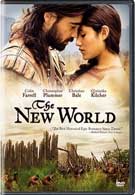Attempting to document the landing of English settlers in Jamestown, Virginia and their relationship with the Native Americans, The New World gets tongue-tied through its use of voice-overs and trips over its own art film want-to-be presentation to truly portray the events in a realistic manner. The result is a forgettable film with remarkable production value. While Hollywood usually can’t wait to sink its teeth into movies based on historical events and glorify the favored party while vilifying the foil party, writer/director Terrence Malick’s The New World seeks to do something different - portray the events as close to what actually happened as possible. Unfortunately for Malick, his writing gets in the way of the story, making The New World an elaborate bore.
Malick (The Thin Red Line) attempts to get inside the head of American hero John Smith, played by Colin Farrell, through the use of faux-intelligent, rambling voice-overs that lull the viewers to sleep rather than have them reach a better understanding of the times and tribulations. Farrell does a decent job trying to trick the audience into forgetting that he is Colin Farrell, but his vacant stare and slack-jawed mannerisms shine through. However, the convincing physicality of the Native American actors partially makes up for the inept Farrell.
Although Q’Orianka Kelcher playes the stand-out role of Pocahontas, it is her tribesmen that steal the show. All the Native American actors speak Algonquin, the native language of the area at the time, and don costumes that are close to the actual Native American garb. Their acting is almost purely physical, speaking mostly through body language. The Native American cast is proof that the filmmakers did not want to exploit Native Americans nor perpetuate stereotypes.
Regrettably, the meandering story also veils the impressive design of the film. All the buildings were constructed as close to the way they were back in the 17th century. From the English settlers’ fort to the Native Americans’ dwellings, there is not a moment in the film that appears unauthentic. Malick’s visual style also gives the film a unique look with his constant camera movement and backlighting. But, the end result is a film with a Hollywood budget, but a want-to-be art film presentation. Again, because of Malick’s use of pointless voice-overs as transition, the film is completely conscious of itself, which removes the viewer and solidifies the film as average and forgettable. The DVD is about as average as the film. Presented in its original 2.35 : 1 aspect ratio, the anamorphic transfer is clean and clear, creating the perfect showcase for Malick’s visually inspired film. The audio is what you would expect from your standard Dolby Digital 5.1 mix, and there is also an available and useless Dolby Digital 2.0 mix, with optional English and Spanish subtitles.
The DVD includes both the teaser and theatrical trailers for the film (along a slew of other previews), which shows how poorly marketed the film was. In retrospect, with a film that desperately wants to be more artistic than it actually is, the only way to market it to an American audience is to make them think that it is a fast-paced action movie set in the 17th century and that Pocahontas may burst out into “Colors of the Wind” at any moment.
The DVD’s best and only feature is the 60 minute “Making of The New World” documentary. While the film is lackluster, this documentary shows the research and care the material was handled with. The early pre-production section of the documentary is by far more interesting than the actual production. We see the struggle of the filmmakers quest for acceptance from the local Native American decedents before production, and we are invited to an intensive training camp for the actors to be transformed into colonists and 17th century Native Americans. After seeing all the hard work the cast and crew put into filming, it is disappointing that the film couldn’t get over itself to let the production value shine through.
Your Daily Blend of Entertainment News

